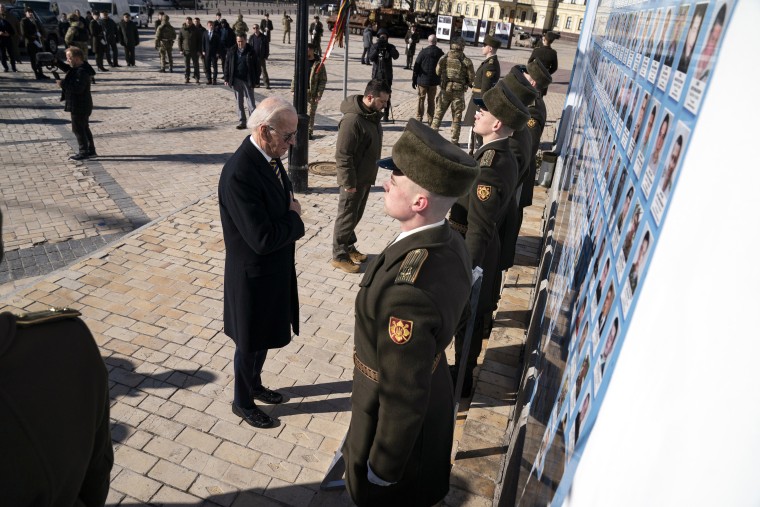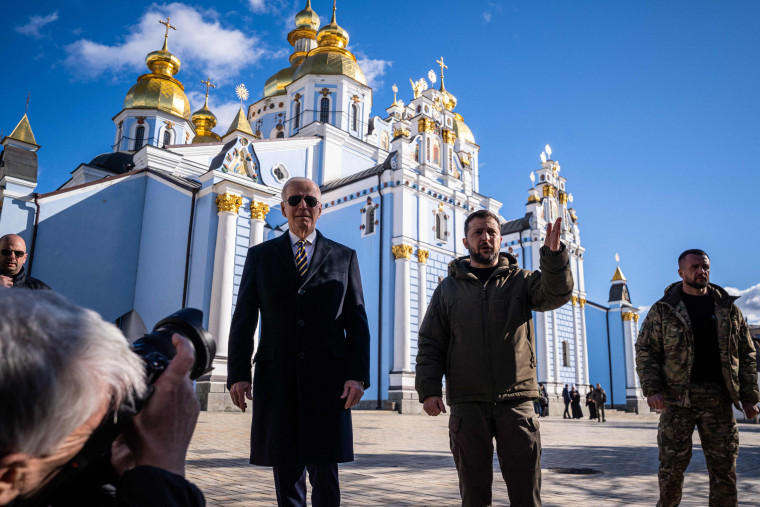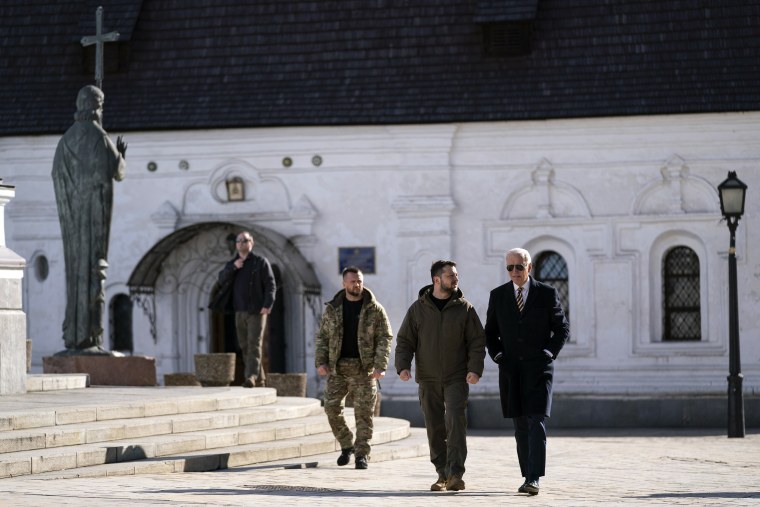WARSAW, Poland — President Joe Biden made a surprise and historic visit to war-torn Ukraine on Monday, a show of support and solidarity with a democratic nation battling for its survival after Russia invaded nearly a year ago.
News of the visit, including a meeting with Ukrainian President Volodymyr Zelenskyy, was kept tightly under wraps until Biden arrived.
"Unchecked aggression is a threat to all of us," Biden said. "One year later, Kyiv stands and Ukraine stands. Democracy stands, Americans stand with you, and the world stands with you."
"Kyiv has captured a part of my heart," he added.
After he arrived in Ukraine on Monday morning local time after a roughly 10-hour overnight train ride from Poland, Biden visited the Mariinsky Palace, where he signed a guest book and made brief remarks alongside Zelenskyy. Biden also visited the U.S. Embassy in Kyiv. He arrived back in Poland shortly after 8 p.m. local time Monday, according to the media pool, again taking the train.
The clandestine nature of the trip points to the dangers of America's commander-in-chief visiting Ukraine amid continuing bombardment, as Russia continued firing missiles into the country hoping to break an impasse as the war enters its second year. Air raid sirens sounded while Biden was on the ground.

In a sign of how sensitive the trip was, the White House had notified the Kremlin of Biden’s visit ahead of time "for deconfliction purposes,” national security adviser Jake Sullivan said. John Kirby, the coordinator for strategic communications at the National Security Council, described the call as "cursory" and "relatively perfunctory."
"We did it at the right time, not too far in advance, but at the right time to make sure they knew what was happening and there was no doubt in how we were going to execute this," Kirby said in an interview on MSNBC.
It is the first time in modern history that a U.S. president has entered a war zone where there is not an active U.S. military presence. Ukrainian police and military forces had a strong presence, and much of the central part of Kyiv was shut down, paralyzing traffic nearby.
Biden’s appearance in Ukraine is a strong statement that the U.S. stands with Zelenskyy despite growing pressure at home to downsize U.S. aid.
“The first visit of the President of the United States to Ukraine in almost 15 years is the most important visit in the history of Ukrainian-American relations,” Zelenskyy posted on the social media site Telegram after the trip.
Biden insisted that the U.S. will remain steadfast in its support of Ukraine.
"For all the disagreement we have in our Congress on some issues, there is significant agreement on support for Ukraine,” he said.
He announced an additional aid package worth $460 million, which will include more military equipment and weapons like anti-tank Javelin missiles.
Zelenskyy said that when Russia invaded, the U.S. was the first to call him in support.
Biden also recalled speaking to Zelenskyy — and the promise he made to help "rally the world" to Ukraine's cause.
“Russian planes were in the air, and tanks were rolling across your border," Biden said. "You told me you could hear explosions in the background. I’ll never forget that. And the world was about to change. I remember it vividly."
The two leaders greeted each other with a sense of familiarity.
“Thank you for coming,” Zelenskyy said, according to a media pool report.
“More importantly, how are the children?” Biden said. He added, “It’s amazing to see you.”
The two leaders visited St. Michael’s Golden-Domed Monastery and then walked to the nearby Wall of Remembrance, which honors those who have died in the war.
Former House Speaker Nancy Pelosi, D-Calif., said in a statement that the visit was a "powerful statement of America’s unshakeable support for the heroic people of Ukraine."
“On this Presidents’ Day, our President’s historic visit to Kyiv at this critical moment is a manifestation of America’s commitment to Democracy, in Ukraine and in the world," Pelosi said.
The trip came with risks. Other presidents have visited war zones: Barack Obama traveled to Afghanistan in 2014, and George W. Bush visited U.S. troops in Iraq in 2003. As was the case with Biden, both traveled under strict secrecy.
But unlike them, Biden did not have the support of the U.S. military on the ground in Ukraine to help ensure his security, Kirby said. He said Biden was briefed about the final version of the plan Friday afternoon and decided then to proceed.
“Biden was briefed on that final bit of planning Friday afternoon and decided the risks were mitigated to the point that he was comfortable moving ahead, so we executed," Kirby said in an interview on MSNBC.
White House officials had been adamant that Warsaw would be Biden’s only stop. On Friday, a White House spokesman answered with a single word when asked whether Biden intended to cross the border into neighboring Ukraine: “No.”
Now, the adversary is Russia. If President Vladimir Putin's military were to intentionally target Biden or even inadvertently harm the president by way of an errant missile, the U.S. would be obligated to retaliate. That could escalate a regional war into a direct conflict between two nuclear-armed countries.
Still, ahead of the trip, some analysts were hopeful that Poland would not be Biden's only stop. A trip to Ukraine "would be a powerful demonstration of support and signal a robust change in policy — a more forward-leaning and fulsome approach to Ukrainian support," said Alexander Vindman, the former director of European affairs in the Donald Trump White House National Security Council.

Biden has invested considerable political, military and financial capital in the war, keeping overmatched Ukraine viable against larger Russian forces. In addition to U.S. assistance, he has pressed the rest of the NATO alliance to shore up Ukraine, arguing it is imperative for the democratic world to counter Russian aggression for two reasons. One is to deter Putin from widening the war into NATO countries; another is to discourage China's authoritarian government from launching its own attacks on smaller countries such as Taiwan.
The U.S. has also begun to sound warnings that the Chinese are providing military assistance to the Russian effort and cautioned China against providing lethal aid.
China has provided some broader help to Russia, including parroting Russian disinformation and promoting Russia's false pretexts for the war. But U.S. officials say the Chinese are now providing more tangible assistance for Russian troops in Ukraine. China has denied providing military assistance.
Biden and Zelenskyy met in Washington in December, when Zelenskyy traveled to the U.S. Capitol and delivered an address to a joint meeting of Congress. Zelenskyy has only sparingly left his country since the invasion.
With fighting picking up, Zelenskyy has been pressing Washington for more advanced fighter jets. So far, Biden has refused out of concern that the F-16 planes might escalate the conflict.
Biden announced last month that the U.S. would send 31 Abrams tanks, which he was initially reluctant to do. The U.S. will also provide training for the tanks.

Biden also faces cross-pressures from conservative Republicans, who believe the U.S. has already given enough money and arms to Ukraine and should now press for a peace deal.
The amount of U.S. military assistance to Ukraine is nearing $30 billion. Polling shows that Americans' support for Ukraine remains strong, although less so as time passes. In May — three months into the war — 60% of Americans favored supplying weapons to Ukraine. As of January, that number had slipped to 48%, according to an Associated Press-NORC Center for Public Affairs Research poll released last week. The percentage of adults who favored sending taxpayer money directly to Ukraine dropped by 7 percentage points in that time — from 44% to 37%.
The war has stretched on longer than most in the West expected; initial estimates had been that Ukraine would be able to hang on for only a few weeks before Russia seized Kyiv, ousted Zelenskyy and absorbed the country into its orbit. Instead, Ukraine proved to be a more resilient opponent than anticipated.
Peter Nicholas reported from Warsaw and Cat Corrigan and Susan Kroll from Kyiv.
